Accounting for Lease: Critical Review of AASB 16 and AASB 117
VerifiedAdded on 2023/03/31
|10
|3621
|366
Report
AI Summary
This report critically evaluates the Australian accounting standards for lease financing, focusing on AASB 16 and its predecessor, AASB 117. It analyzes the drawbacks of AASB 117, such as the classification of leases as operating or finance leases and the resulting off-balance-sheet liabilities, which allowed companies to misrepresent their financial positions. The report highlights the essentiality of the changes introduced by AASB 16, which eliminates lease classification and mandates the recognition of right-of-use assets and lease liabilities. The report examines the effects of AASB 16 on companies with significant lease financing, potentially increasing their reported liabilities and impacting profitability. Furthermore, the report discusses the propensity of companies to classify leases as operating leases under AASB 117 and how AASB 16 improves the comparability of financial information. Finally, the report includes a case study on Woolworths' lease accounting practices, demonstrating the practical application of the standards.

Running head: ACCOUNTING THEORY AND CURRENT ISSUES
Accounting Theory and Current Issues
Name of the Student
Name of the University
Author’s Note
Accounting Theory and Current Issues
Name of the Student
Name of the University
Author’s Note
Paraphrase This Document
Need a fresh take? Get an instant paraphrase of this document with our AI Paraphraser
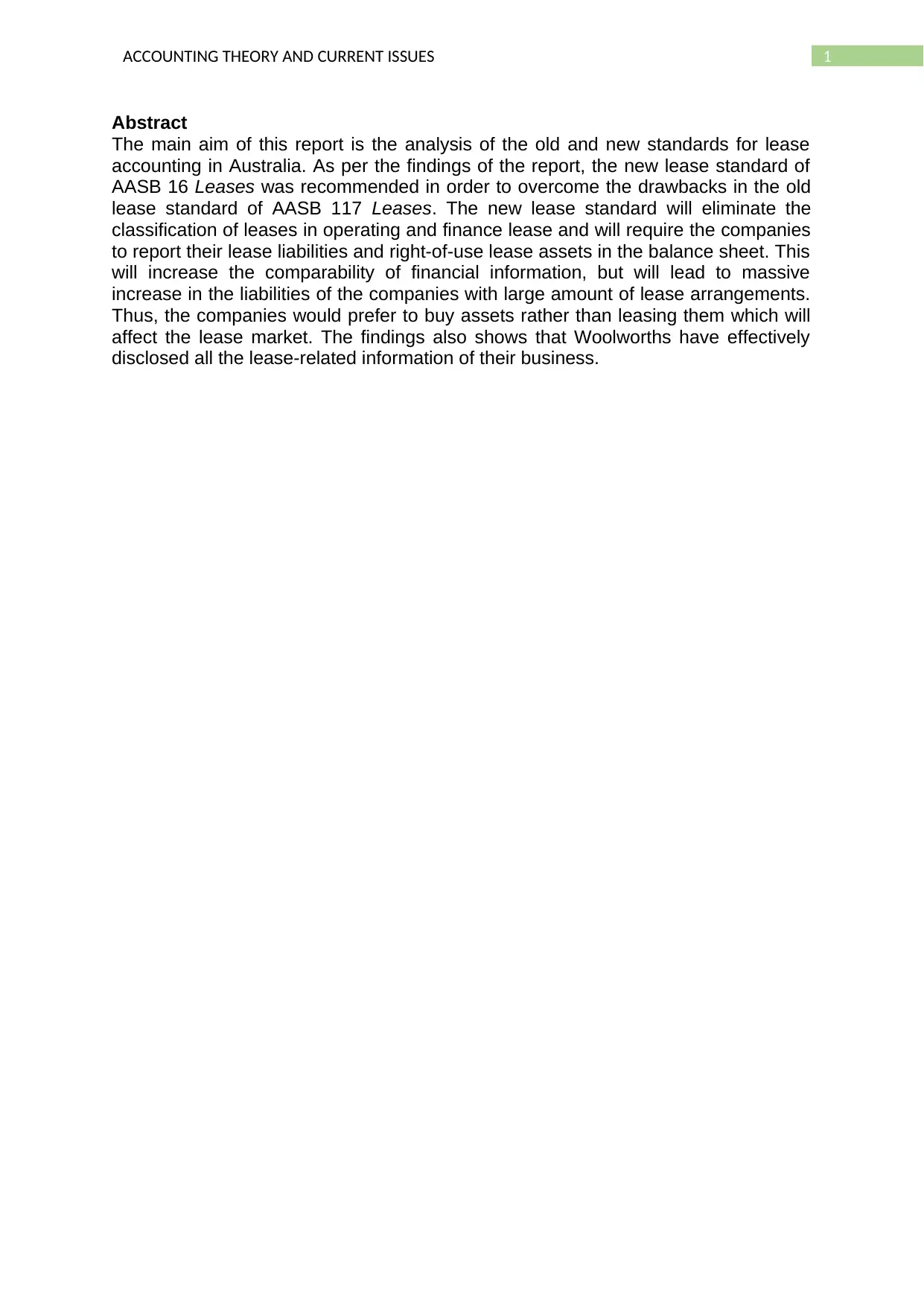
1ACCOUNTING THEORY AND CURRENT ISSUES
Abstract
The main aim of this report is the analysis of the old and new standards for lease
accounting in Australia. As per the findings of the report, the new lease standard of
AASB 16 Leases was recommended in order to overcome the drawbacks in the old
lease standard of AASB 117 Leases. The new lease standard will eliminate the
classification of leases in operating and finance lease and will require the companies
to report their lease liabilities and right-of-use lease assets in the balance sheet. This
will increase the comparability of financial information, but will lead to massive
increase in the liabilities of the companies with large amount of lease arrangements.
Thus, the companies would prefer to buy assets rather than leasing them which will
affect the lease market. The findings also shows that Woolworths have effectively
disclosed all the lease-related information of their business.
Abstract
The main aim of this report is the analysis of the old and new standards for lease
accounting in Australia. As per the findings of the report, the new lease standard of
AASB 16 Leases was recommended in order to overcome the drawbacks in the old
lease standard of AASB 117 Leases. The new lease standard will eliminate the
classification of leases in operating and finance lease and will require the companies
to report their lease liabilities and right-of-use lease assets in the balance sheet. This
will increase the comparability of financial information, but will lead to massive
increase in the liabilities of the companies with large amount of lease arrangements.
Thus, the companies would prefer to buy assets rather than leasing them which will
affect the lease market. The findings also shows that Woolworths have effectively
disclosed all the lease-related information of their business.
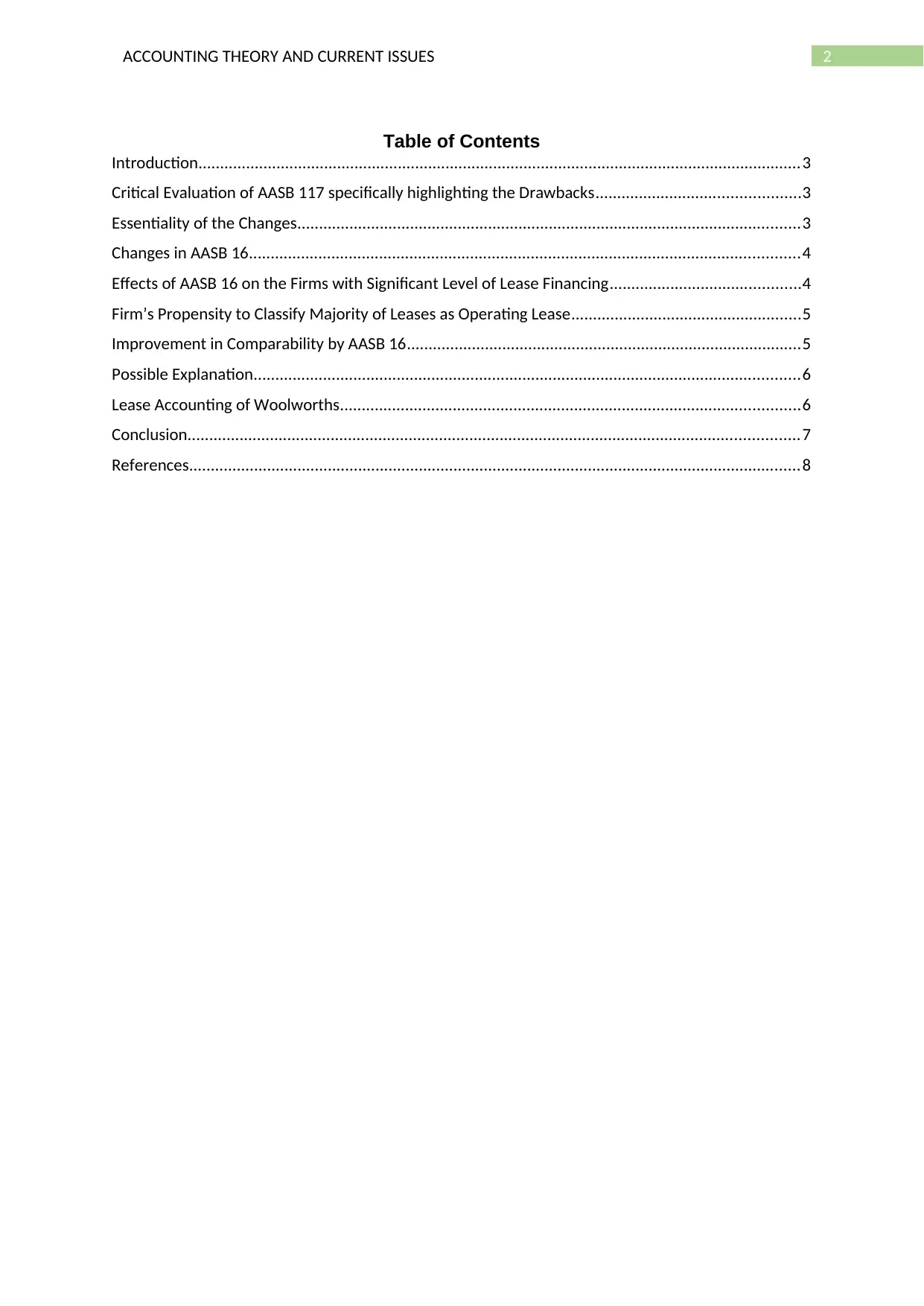
2ACCOUNTING THEORY AND CURRENT ISSUES
Table of Contents
Introduction...........................................................................................................................................3
Critical Evaluation of AASB 117 specifically highlighting the Drawbacks...............................................3
Essentiality of the Changes....................................................................................................................3
Changes in AASB 16...............................................................................................................................4
Effects of AASB 16 on the Firms with Significant Level of Lease Financing............................................4
Firm’s Propensity to Classify Majority of Leases as Operating Lease.....................................................5
Improvement in Comparability by AASB 16...........................................................................................5
Possible Explanation..............................................................................................................................6
Lease Accounting of Woolworths..........................................................................................................6
Conclusion.............................................................................................................................................7
References.............................................................................................................................................8
Table of Contents
Introduction...........................................................................................................................................3
Critical Evaluation of AASB 117 specifically highlighting the Drawbacks...............................................3
Essentiality of the Changes....................................................................................................................3
Changes in AASB 16...............................................................................................................................4
Effects of AASB 16 on the Firms with Significant Level of Lease Financing............................................4
Firm’s Propensity to Classify Majority of Leases as Operating Lease.....................................................5
Improvement in Comparability by AASB 16...........................................................................................5
Possible Explanation..............................................................................................................................6
Lease Accounting of Woolworths..........................................................................................................6
Conclusion.............................................................................................................................................7
References.............................................................................................................................................8
⊘ This is a preview!⊘
Do you want full access?
Subscribe today to unlock all pages.

Trusted by 1+ million students worldwide
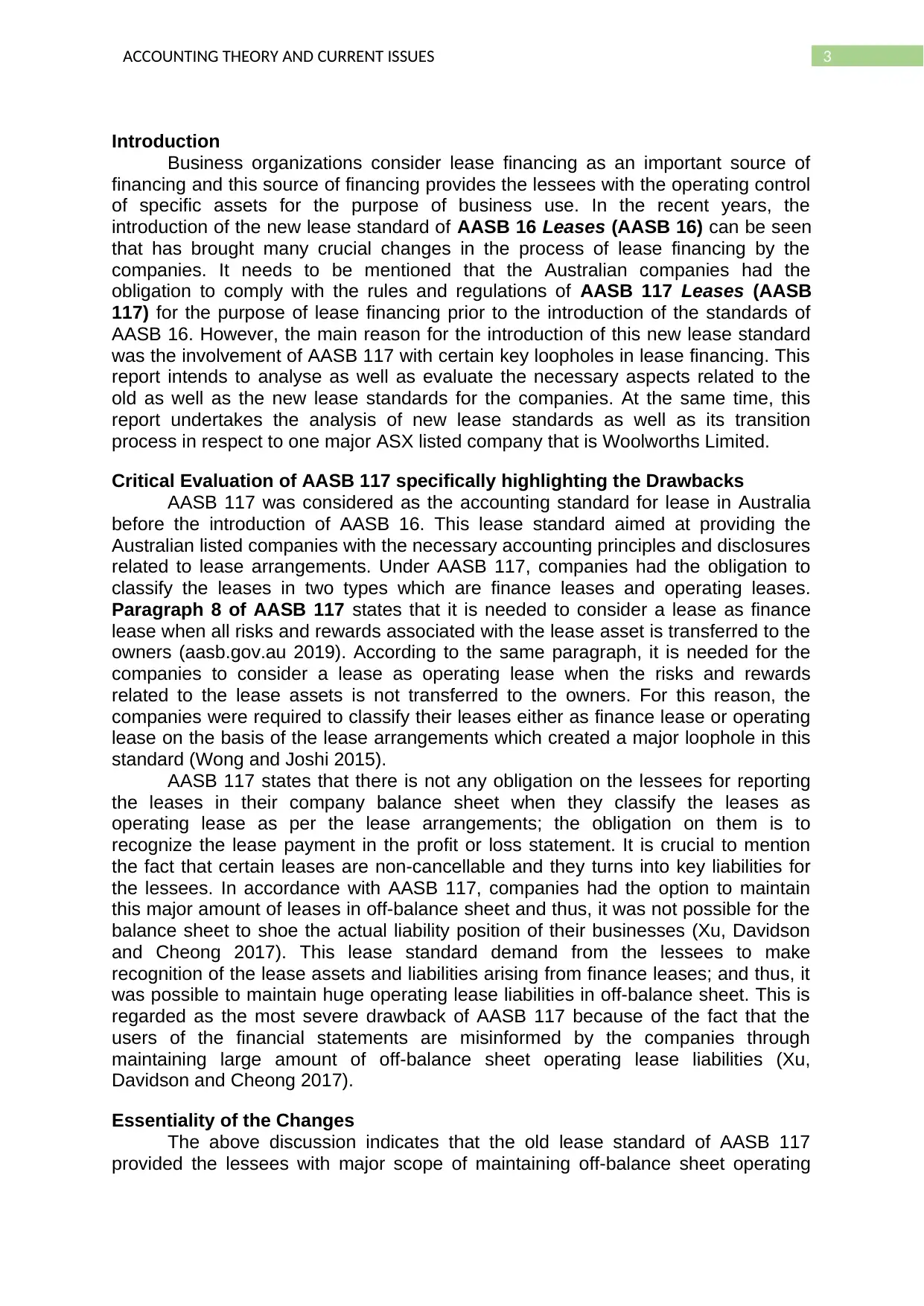
3ACCOUNTING THEORY AND CURRENT ISSUES
Introduction
Business organizations consider lease financing as an important source of
financing and this source of financing provides the lessees with the operating control
of specific assets for the purpose of business use. In the recent years, the
introduction of the new lease standard of AASB 16 Leases (AASB 16) can be seen
that has brought many crucial changes in the process of lease financing by the
companies. It needs to be mentioned that the Australian companies had the
obligation to comply with the rules and regulations of AASB 117 Leases (AASB
117) for the purpose of lease financing prior to the introduction of the standards of
AASB 16. However, the main reason for the introduction of this new lease standard
was the involvement of AASB 117 with certain key loopholes in lease financing. This
report intends to analyse as well as evaluate the necessary aspects related to the
old as well as the new lease standards for the companies. At the same time, this
report undertakes the analysis of new lease standards as well as its transition
process in respect to one major ASX listed company that is Woolworths Limited.
Critical Evaluation of AASB 117 specifically highlighting the Drawbacks
AASB 117 was considered as the accounting standard for lease in Australia
before the introduction of AASB 16. This lease standard aimed at providing the
Australian listed companies with the necessary accounting principles and disclosures
related to lease arrangements. Under AASB 117, companies had the obligation to
classify the leases in two types which are finance leases and operating leases.
Paragraph 8 of AASB 117 states that it is needed to consider a lease as finance
lease when all risks and rewards associated with the lease asset is transferred to the
owners (aasb.gov.au 2019). According to the same paragraph, it is needed for the
companies to consider a lease as operating lease when the risks and rewards
related to the lease assets is not transferred to the owners. For this reason, the
companies were required to classify their leases either as finance lease or operating
lease on the basis of the lease arrangements which created a major loophole in this
standard (Wong and Joshi 2015).
AASB 117 states that there is not any obligation on the lessees for reporting
the leases in their company balance sheet when they classify the leases as
operating lease as per the lease arrangements; the obligation on them is to
recognize the lease payment in the profit or loss statement. It is crucial to mention
the fact that certain leases are non-cancellable and they turns into key liabilities for
the lessees. In accordance with AASB 117, companies had the option to maintain
this major amount of leases in off-balance sheet and thus, it was not possible for the
balance sheet to shoe the actual liability position of their businesses (Xu, Davidson
and Cheong 2017). This lease standard demand from the lessees to make
recognition of the lease assets and liabilities arising from finance leases; and thus, it
was possible to maintain huge operating lease liabilities in off-balance sheet. This is
regarded as the most severe drawback of AASB 117 because of the fact that the
users of the financial statements are misinformed by the companies through
maintaining large amount of off-balance sheet operating lease liabilities (Xu,
Davidson and Cheong 2017).
Essentiality of the Changes
The above discussion indicates that the old lease standard of AASB 117
provided the lessees with major scope of maintaining off-balance sheet operating
Introduction
Business organizations consider lease financing as an important source of
financing and this source of financing provides the lessees with the operating control
of specific assets for the purpose of business use. In the recent years, the
introduction of the new lease standard of AASB 16 Leases (AASB 16) can be seen
that has brought many crucial changes in the process of lease financing by the
companies. It needs to be mentioned that the Australian companies had the
obligation to comply with the rules and regulations of AASB 117 Leases (AASB
117) for the purpose of lease financing prior to the introduction of the standards of
AASB 16. However, the main reason for the introduction of this new lease standard
was the involvement of AASB 117 with certain key loopholes in lease financing. This
report intends to analyse as well as evaluate the necessary aspects related to the
old as well as the new lease standards for the companies. At the same time, this
report undertakes the analysis of new lease standards as well as its transition
process in respect to one major ASX listed company that is Woolworths Limited.
Critical Evaluation of AASB 117 specifically highlighting the Drawbacks
AASB 117 was considered as the accounting standard for lease in Australia
before the introduction of AASB 16. This lease standard aimed at providing the
Australian listed companies with the necessary accounting principles and disclosures
related to lease arrangements. Under AASB 117, companies had the obligation to
classify the leases in two types which are finance leases and operating leases.
Paragraph 8 of AASB 117 states that it is needed to consider a lease as finance
lease when all risks and rewards associated with the lease asset is transferred to the
owners (aasb.gov.au 2019). According to the same paragraph, it is needed for the
companies to consider a lease as operating lease when the risks and rewards
related to the lease assets is not transferred to the owners. For this reason, the
companies were required to classify their leases either as finance lease or operating
lease on the basis of the lease arrangements which created a major loophole in this
standard (Wong and Joshi 2015).
AASB 117 states that there is not any obligation on the lessees for reporting
the leases in their company balance sheet when they classify the leases as
operating lease as per the lease arrangements; the obligation on them is to
recognize the lease payment in the profit or loss statement. It is crucial to mention
the fact that certain leases are non-cancellable and they turns into key liabilities for
the lessees. In accordance with AASB 117, companies had the option to maintain
this major amount of leases in off-balance sheet and thus, it was not possible for the
balance sheet to shoe the actual liability position of their businesses (Xu, Davidson
and Cheong 2017). This lease standard demand from the lessees to make
recognition of the lease assets and liabilities arising from finance leases; and thus, it
was possible to maintain huge operating lease liabilities in off-balance sheet. This is
regarded as the most severe drawback of AASB 117 because of the fact that the
users of the financial statements are misinformed by the companies through
maintaining large amount of off-balance sheet operating lease liabilities (Xu,
Davidson and Cheong 2017).
Essentiality of the Changes
The above discussion indicates that the old lease standard of AASB 117
provided the lessees with major scope of maintaining off-balance sheet operating
Paraphrase This Document
Need a fresh take? Get an instant paraphrase of this document with our AI Paraphraser
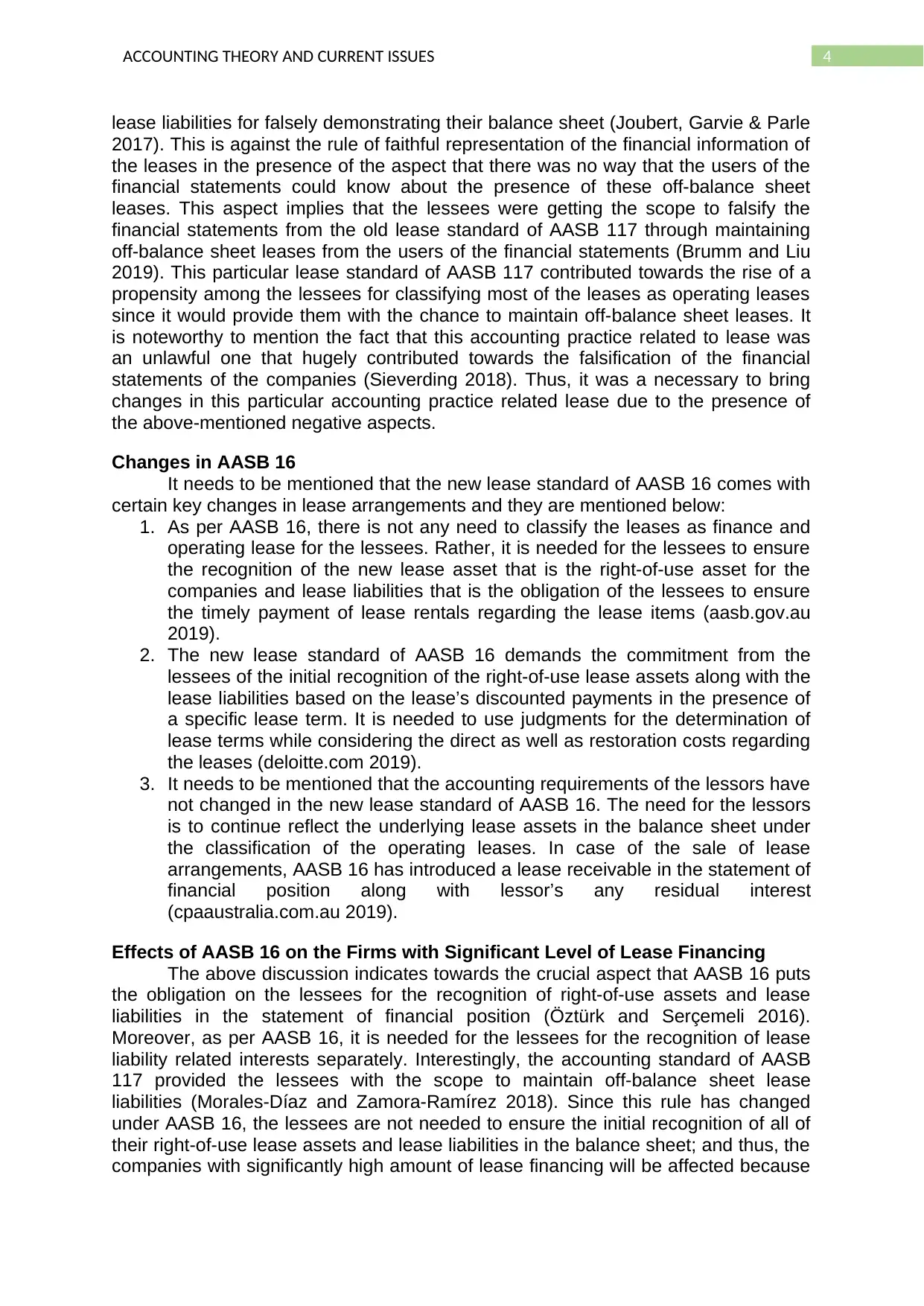
4ACCOUNTING THEORY AND CURRENT ISSUES
lease liabilities for falsely demonstrating their balance sheet (Joubert, Garvie & Parle
2017). This is against the rule of faithful representation of the financial information of
the leases in the presence of the aspect that there was no way that the users of the
financial statements could know about the presence of these off-balance sheet
leases. This aspect implies that the lessees were getting the scope to falsify the
financial statements from the old lease standard of AASB 117 through maintaining
off-balance sheet leases from the users of the financial statements (Brumm and Liu
2019). This particular lease standard of AASB 117 contributed towards the rise of a
propensity among the lessees for classifying most of the leases as operating leases
since it would provide them with the chance to maintain off-balance sheet leases. It
is noteworthy to mention the fact that this accounting practice related to lease was
an unlawful one that hugely contributed towards the falsification of the financial
statements of the companies (Sieverding 2018). Thus, it was a necessary to bring
changes in this particular accounting practice related lease due to the presence of
the above-mentioned negative aspects.
Changes in AASB 16
It needs to be mentioned that the new lease standard of AASB 16 comes with
certain key changes in lease arrangements and they are mentioned below:
1. As per AASB 16, there is not any need to classify the leases as finance and
operating lease for the lessees. Rather, it is needed for the lessees to ensure
the recognition of the new lease asset that is the right-of-use asset for the
companies and lease liabilities that is the obligation of the lessees to ensure
the timely payment of lease rentals regarding the lease items (aasb.gov.au
2019).
2. The new lease standard of AASB 16 demands the commitment from the
lessees of the initial recognition of the right-of-use lease assets along with the
lease liabilities based on the lease’s discounted payments in the presence of
a specific lease term. It is needed to use judgments for the determination of
lease terms while considering the direct as well as restoration costs regarding
the leases (deloitte.com 2019).
3. It needs to be mentioned that the accounting requirements of the lessors have
not changed in the new lease standard of AASB 16. The need for the lessors
is to continue reflect the underlying lease assets in the balance sheet under
the classification of the operating leases. In case of the sale of lease
arrangements, AASB 16 has introduced a lease receivable in the statement of
financial position along with lessor’s any residual interest
(cpaaustralia.com.au 2019).
Effects of AASB 16 on the Firms with Significant Level of Lease Financing
The above discussion indicates towards the crucial aspect that AASB 16 puts
the obligation on the lessees for the recognition of right-of-use assets and lease
liabilities in the statement of financial position (Öztürk and Serçemeli 2016).
Moreover, as per AASB 16, it is needed for the lessees for the recognition of lease
liability related interests separately. Interestingly, the accounting standard of AASB
117 provided the lessees with the scope to maintain off-balance sheet lease
liabilities (Morales-Díaz and Zamora-Ramírez 2018). Since this rule has changed
under AASB 16, the lessees are not needed to ensure the initial recognition of all of
their right-of-use lease assets and lease liabilities in the balance sheet; and thus, the
companies with significantly high amount of lease financing will be affected because
lease liabilities for falsely demonstrating their balance sheet (Joubert, Garvie & Parle
2017). This is against the rule of faithful representation of the financial information of
the leases in the presence of the aspect that there was no way that the users of the
financial statements could know about the presence of these off-balance sheet
leases. This aspect implies that the lessees were getting the scope to falsify the
financial statements from the old lease standard of AASB 117 through maintaining
off-balance sheet leases from the users of the financial statements (Brumm and Liu
2019). This particular lease standard of AASB 117 contributed towards the rise of a
propensity among the lessees for classifying most of the leases as operating leases
since it would provide them with the chance to maintain off-balance sheet leases. It
is noteworthy to mention the fact that this accounting practice related to lease was
an unlawful one that hugely contributed towards the falsification of the financial
statements of the companies (Sieverding 2018). Thus, it was a necessary to bring
changes in this particular accounting practice related lease due to the presence of
the above-mentioned negative aspects.
Changes in AASB 16
It needs to be mentioned that the new lease standard of AASB 16 comes with
certain key changes in lease arrangements and they are mentioned below:
1. As per AASB 16, there is not any need to classify the leases as finance and
operating lease for the lessees. Rather, it is needed for the lessees to ensure
the recognition of the new lease asset that is the right-of-use asset for the
companies and lease liabilities that is the obligation of the lessees to ensure
the timely payment of lease rentals regarding the lease items (aasb.gov.au
2019).
2. The new lease standard of AASB 16 demands the commitment from the
lessees of the initial recognition of the right-of-use lease assets along with the
lease liabilities based on the lease’s discounted payments in the presence of
a specific lease term. It is needed to use judgments for the determination of
lease terms while considering the direct as well as restoration costs regarding
the leases (deloitte.com 2019).
3. It needs to be mentioned that the accounting requirements of the lessors have
not changed in the new lease standard of AASB 16. The need for the lessors
is to continue reflect the underlying lease assets in the balance sheet under
the classification of the operating leases. In case of the sale of lease
arrangements, AASB 16 has introduced a lease receivable in the statement of
financial position along with lessor’s any residual interest
(cpaaustralia.com.au 2019).
Effects of AASB 16 on the Firms with Significant Level of Lease Financing
The above discussion indicates towards the crucial aspect that AASB 16 puts
the obligation on the lessees for the recognition of right-of-use assets and lease
liabilities in the statement of financial position (Öztürk and Serçemeli 2016).
Moreover, as per AASB 16, it is needed for the lessees for the recognition of lease
liability related interests separately. Interestingly, the accounting standard of AASB
117 provided the lessees with the scope to maintain off-balance sheet lease
liabilities (Morales-Díaz and Zamora-Ramírez 2018). Since this rule has changed
under AASB 16, the lessees are not needed to ensure the initial recognition of all of
their right-of-use lease assets and lease liabilities in the balance sheet; and thus, the
companies with significantly high amount of lease financing will be affected because
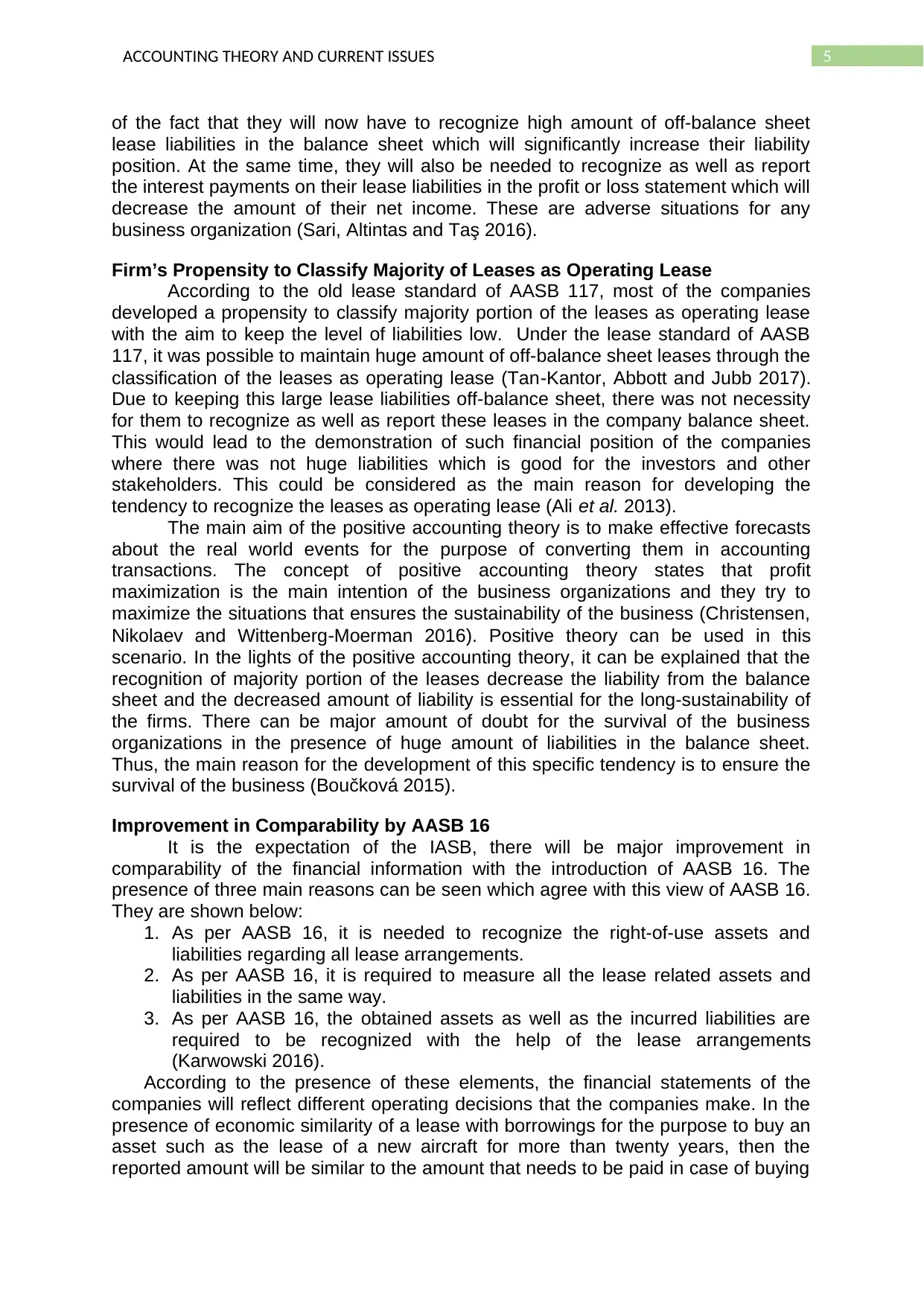
5ACCOUNTING THEORY AND CURRENT ISSUES
of the fact that they will now have to recognize high amount of off-balance sheet
lease liabilities in the balance sheet which will significantly increase their liability
position. At the same time, they will also be needed to recognize as well as report
the interest payments on their lease liabilities in the profit or loss statement which will
decrease the amount of their net income. These are adverse situations for any
business organization (Sari, Altintas and Taş 2016).
Firm’s Propensity to Classify Majority of Leases as Operating Lease
According to the old lease standard of AASB 117, most of the companies
developed a propensity to classify majority portion of the leases as operating lease
with the aim to keep the level of liabilities low. Under the lease standard of AASB
117, it was possible to maintain huge amount of off-balance sheet leases through the
classification of the leases as operating lease (Tan‐Kantor, Abbott and Jubb 2017).
Due to keeping this large lease liabilities off-balance sheet, there was not necessity
for them to recognize as well as report these leases in the company balance sheet.
This would lead to the demonstration of such financial position of the companies
where there was not huge liabilities which is good for the investors and other
stakeholders. This could be considered as the main reason for developing the
tendency to recognize the leases as operating lease (Ali et al. 2013).
The main aim of the positive accounting theory is to make effective forecasts
about the real world events for the purpose of converting them in accounting
transactions. The concept of positive accounting theory states that profit
maximization is the main intention of the business organizations and they try to
maximize the situations that ensures the sustainability of the business (Christensen,
Nikolaev and Wittenberg‐Moerman 2016). Positive theory can be used in this
scenario. In the lights of the positive accounting theory, it can be explained that the
recognition of majority portion of the leases decrease the liability from the balance
sheet and the decreased amount of liability is essential for the long-sustainability of
the firms. There can be major amount of doubt for the survival of the business
organizations in the presence of huge amount of liabilities in the balance sheet.
Thus, the main reason for the development of this specific tendency is to ensure the
survival of the business (Boučková 2015).
Improvement in Comparability by AASB 16
It is the expectation of the IASB, there will be major improvement in
comparability of the financial information with the introduction of AASB 16. The
presence of three main reasons can be seen which agree with this view of AASB 16.
They are shown below:
1. As per AASB 16, it is needed to recognize the right-of-use assets and
liabilities regarding all lease arrangements.
2. As per AASB 16, it is required to measure all the lease related assets and
liabilities in the same way.
3. As per AASB 16, the obtained assets as well as the incurred liabilities are
required to be recognized with the help of the lease arrangements
(Karwowski 2016).
According to the presence of these elements, the financial statements of the
companies will reflect different operating decisions that the companies make. In the
presence of economic similarity of a lease with borrowings for the purpose to buy an
asset such as the lease of a new aircraft for more than twenty years, then the
reported amount will be similar to the amount that needs to be paid in case of buying
of the fact that they will now have to recognize high amount of off-balance sheet
lease liabilities in the balance sheet which will significantly increase their liability
position. At the same time, they will also be needed to recognize as well as report
the interest payments on their lease liabilities in the profit or loss statement which will
decrease the amount of their net income. These are adverse situations for any
business organization (Sari, Altintas and Taş 2016).
Firm’s Propensity to Classify Majority of Leases as Operating Lease
According to the old lease standard of AASB 117, most of the companies
developed a propensity to classify majority portion of the leases as operating lease
with the aim to keep the level of liabilities low. Under the lease standard of AASB
117, it was possible to maintain huge amount of off-balance sheet leases through the
classification of the leases as operating lease (Tan‐Kantor, Abbott and Jubb 2017).
Due to keeping this large lease liabilities off-balance sheet, there was not necessity
for them to recognize as well as report these leases in the company balance sheet.
This would lead to the demonstration of such financial position of the companies
where there was not huge liabilities which is good for the investors and other
stakeholders. This could be considered as the main reason for developing the
tendency to recognize the leases as operating lease (Ali et al. 2013).
The main aim of the positive accounting theory is to make effective forecasts
about the real world events for the purpose of converting them in accounting
transactions. The concept of positive accounting theory states that profit
maximization is the main intention of the business organizations and they try to
maximize the situations that ensures the sustainability of the business (Christensen,
Nikolaev and Wittenberg‐Moerman 2016). Positive theory can be used in this
scenario. In the lights of the positive accounting theory, it can be explained that the
recognition of majority portion of the leases decrease the liability from the balance
sheet and the decreased amount of liability is essential for the long-sustainability of
the firms. There can be major amount of doubt for the survival of the business
organizations in the presence of huge amount of liabilities in the balance sheet.
Thus, the main reason for the development of this specific tendency is to ensure the
survival of the business (Boučková 2015).
Improvement in Comparability by AASB 16
It is the expectation of the IASB, there will be major improvement in
comparability of the financial information with the introduction of AASB 16. The
presence of three main reasons can be seen which agree with this view of AASB 16.
They are shown below:
1. As per AASB 16, it is needed to recognize the right-of-use assets and
liabilities regarding all lease arrangements.
2. As per AASB 16, it is required to measure all the lease related assets and
liabilities in the same way.
3. As per AASB 16, the obtained assets as well as the incurred liabilities are
required to be recognized with the help of the lease arrangements
(Karwowski 2016).
According to the presence of these elements, the financial statements of the
companies will reflect different operating decisions that the companies make. In the
presence of economic similarity of a lease with borrowings for the purpose to buy an
asset such as the lease of a new aircraft for more than twenty years, then the
reported amount will be similar to the amount that needs to be paid in case of buying
⊘ This is a preview!⊘
Do you want full access?
Subscribe today to unlock all pages.

Trusted by 1+ million students worldwide

6ACCOUNTING THEORY AND CURRENT ISSUES
or borrowing the assets in accordance with AASB 16 (Blanchette et al. 2013).
However, in the presence of an economic difference between the lease and buy of
an asset such as the lease of a new aircraft for seven years, then the reported
amount will reflect different economic decisions in accordance with AASB 16. In this
case, there will be less amount of reported assets and liabilities’ reported amount in
case it was needed for the company to purchase the aircraft. In this situation, there
will be difference in the right of the company to lease the aircraft for seven years
than the right of the firm to buy or borrow the aircraft (Palea 2013).
Possible Explanation
The above discussion indicates towards the crucial aspect that the companies
with large lease atonements will be majorly affected with the introduction of AASB
16. For instance, the liabilities of the companies will be significantly increased due to
the presence of the obligation of the recognition and reporting of these liabilities in
the balance sheet (Schelle and Baltussen 2013). Thus, the lease market will be
majorly affected with this. Because of the introduction of this new lease standard of
AASB 16, the companies will be profitable in buying the assets that they would be
needed to lease and thus, the companies will be able in showing these assets in
their balance sheet. Due to this recognition of these assets in the balance sheet, the
asset position of these companies will increase for the companies. On the other
hand, in case the companied decide to lease the assets, it will be needed for them to
these lease arrangements as liabilities in the balance sheet; and they will have to
pay the interests or rentals of these lease arrangements. This will be unfavourable
for the companies and the companies will be less interested in leasing (Chen et al.
2015). This will affect the lease market.
Lease Accounting of Woolworths
The presence of certain disclosures can be seen in the 2018 Annual Report of
Woolworths regarding their business lease arrangements and these are discussed
below.
As per the 2018 Annual Report of Woolworths, there is not any finance lease
of the company for the year 2018 due to the fact that the company has made a lease
payment of $2 million against the opening lease. As per the 2018 Annual Report of
Woolworths, the operating lease of the company in 2018 and 2017 was $22,904
million and $24,439 million respectively. The company considers assets for operating
lease from one year to more than five years (woolworthsgroup.com.au 2019).
It can be seen from the 2018 Annual Report of Woolworths that there are
certain accounting policies adopted by the management of the firm for their lease
arrangements. The company has made the classification of leases in finance lease
and operating lease. As per Woolworths, finance lease leads to the transfer of the
risks and rewards related to the leases assets and others are operating leases
(woolworthsgroup.com.au 2019). As per Woolworths, the payments for operating
leases is recognized as an expenses based on straight line method over the lease
term. In addition, the recognition of fixed rate increase in the fixed lease rental
payments are done based on the straight line basis throughout the lease term. For
the incentives for operating lease, they are recognized as the portion of lease
expenses based on straight line method throughout the lease term
(woolworthsgroup.com.au 2019).
According to the 2018 Annual Report of Woolworths, the new lease standards
of AASB 16 Leases will be effective in the company from 01.06.2019 and modified
or borrowing the assets in accordance with AASB 16 (Blanchette et al. 2013).
However, in the presence of an economic difference between the lease and buy of
an asset such as the lease of a new aircraft for seven years, then the reported
amount will reflect different economic decisions in accordance with AASB 16. In this
case, there will be less amount of reported assets and liabilities’ reported amount in
case it was needed for the company to purchase the aircraft. In this situation, there
will be difference in the right of the company to lease the aircraft for seven years
than the right of the firm to buy or borrow the aircraft (Palea 2013).
Possible Explanation
The above discussion indicates towards the crucial aspect that the companies
with large lease atonements will be majorly affected with the introduction of AASB
16. For instance, the liabilities of the companies will be significantly increased due to
the presence of the obligation of the recognition and reporting of these liabilities in
the balance sheet (Schelle and Baltussen 2013). Thus, the lease market will be
majorly affected with this. Because of the introduction of this new lease standard of
AASB 16, the companies will be profitable in buying the assets that they would be
needed to lease and thus, the companies will be able in showing these assets in
their balance sheet. Due to this recognition of these assets in the balance sheet, the
asset position of these companies will increase for the companies. On the other
hand, in case the companied decide to lease the assets, it will be needed for them to
these lease arrangements as liabilities in the balance sheet; and they will have to
pay the interests or rentals of these lease arrangements. This will be unfavourable
for the companies and the companies will be less interested in leasing (Chen et al.
2015). This will affect the lease market.
Lease Accounting of Woolworths
The presence of certain disclosures can be seen in the 2018 Annual Report of
Woolworths regarding their business lease arrangements and these are discussed
below.
As per the 2018 Annual Report of Woolworths, there is not any finance lease
of the company for the year 2018 due to the fact that the company has made a lease
payment of $2 million against the opening lease. As per the 2018 Annual Report of
Woolworths, the operating lease of the company in 2018 and 2017 was $22,904
million and $24,439 million respectively. The company considers assets for operating
lease from one year to more than five years (woolworthsgroup.com.au 2019).
It can be seen from the 2018 Annual Report of Woolworths that there are
certain accounting policies adopted by the management of the firm for their lease
arrangements. The company has made the classification of leases in finance lease
and operating lease. As per Woolworths, finance lease leads to the transfer of the
risks and rewards related to the leases assets and others are operating leases
(woolworthsgroup.com.au 2019). As per Woolworths, the payments for operating
leases is recognized as an expenses based on straight line method over the lease
term. In addition, the recognition of fixed rate increase in the fixed lease rental
payments are done based on the straight line basis throughout the lease term. For
the incentives for operating lease, they are recognized as the portion of lease
expenses based on straight line method throughout the lease term
(woolworthsgroup.com.au 2019).
According to the 2018 Annual Report of Woolworths, the new lease standards
of AASB 16 Leases will be effective in the company from 01.06.2019 and modified
Paraphrase This Document
Need a fresh take? Get an instant paraphrase of this document with our AI Paraphraser
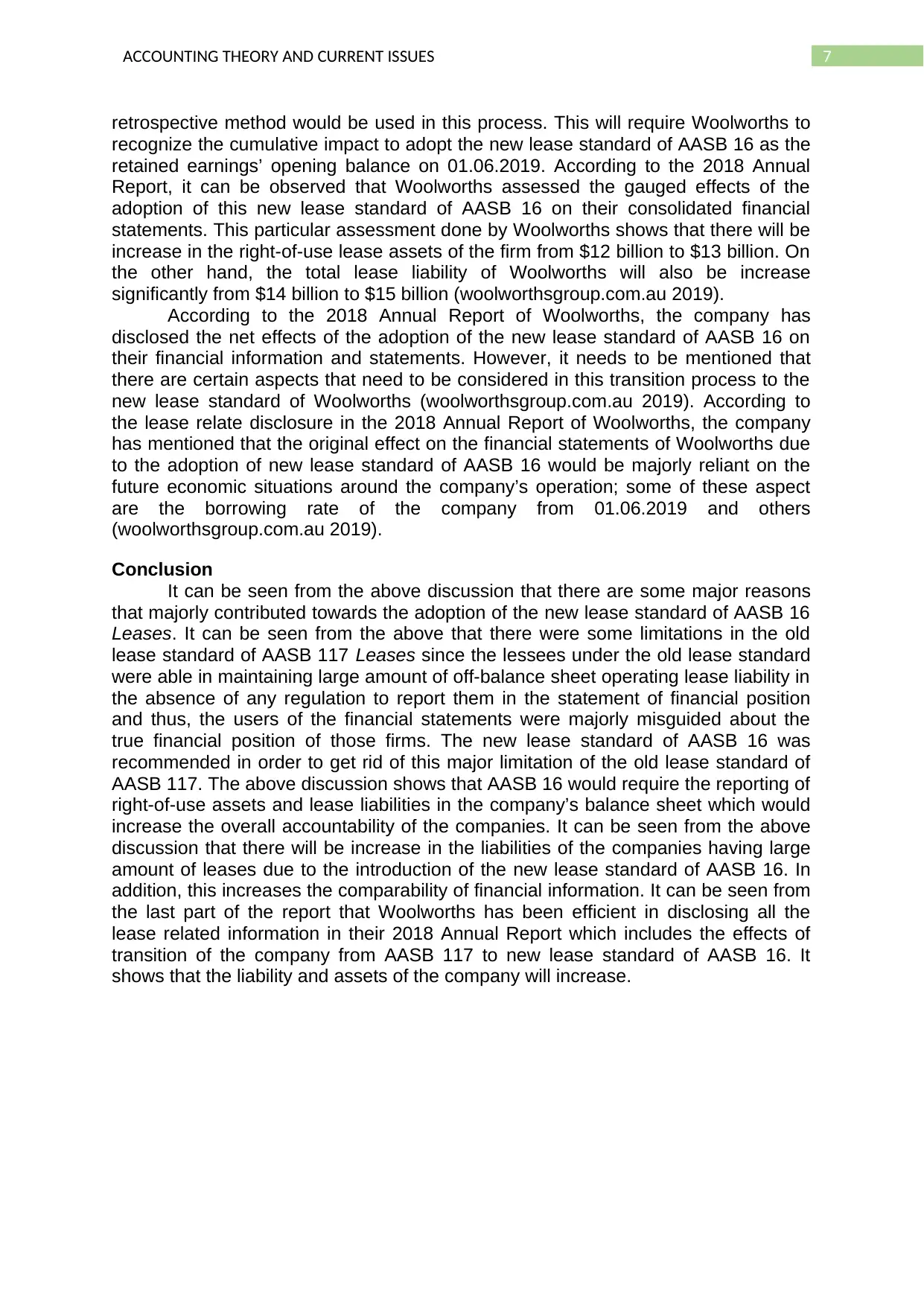
7ACCOUNTING THEORY AND CURRENT ISSUES
retrospective method would be used in this process. This will require Woolworths to
recognize the cumulative impact to adopt the new lease standard of AASB 16 as the
retained earnings’ opening balance on 01.06.2019. According to the 2018 Annual
Report, it can be observed that Woolworths assessed the gauged effects of the
adoption of this new lease standard of AASB 16 on their consolidated financial
statements. This particular assessment done by Woolworths shows that there will be
increase in the right-of-use lease assets of the firm from $12 billion to $13 billion. On
the other hand, the total lease liability of Woolworths will also be increase
significantly from $14 billion to $15 billion (woolworthsgroup.com.au 2019).
According to the 2018 Annual Report of Woolworths, the company has
disclosed the net effects of the adoption of the new lease standard of AASB 16 on
their financial information and statements. However, it needs to be mentioned that
there are certain aspects that need to be considered in this transition process to the
new lease standard of Woolworths (woolworthsgroup.com.au 2019). According to
the lease relate disclosure in the 2018 Annual Report of Woolworths, the company
has mentioned that the original effect on the financial statements of Woolworths due
to the adoption of new lease standard of AASB 16 would be majorly reliant on the
future economic situations around the company’s operation; some of these aspect
are the borrowing rate of the company from 01.06.2019 and others
(woolworthsgroup.com.au 2019).
Conclusion
It can be seen from the above discussion that there are some major reasons
that majorly contributed towards the adoption of the new lease standard of AASB 16
Leases. It can be seen from the above that there were some limitations in the old
lease standard of AASB 117 Leases since the lessees under the old lease standard
were able in maintaining large amount of off-balance sheet operating lease liability in
the absence of any regulation to report them in the statement of financial position
and thus, the users of the financial statements were majorly misguided about the
true financial position of those firms. The new lease standard of AASB 16 was
recommended in order to get rid of this major limitation of the old lease standard of
AASB 117. The above discussion shows that AASB 16 would require the reporting of
right-of-use assets and lease liabilities in the company’s balance sheet which would
increase the overall accountability of the companies. It can be seen from the above
discussion that there will be increase in the liabilities of the companies having large
amount of leases due to the introduction of the new lease standard of AASB 16. In
addition, this increases the comparability of financial information. It can be seen from
the last part of the report that Woolworths has been efficient in disclosing all the
lease related information in their 2018 Annual Report which includes the effects of
transition of the company from AASB 117 to new lease standard of AASB 16. It
shows that the liability and assets of the company will increase.
retrospective method would be used in this process. This will require Woolworths to
recognize the cumulative impact to adopt the new lease standard of AASB 16 as the
retained earnings’ opening balance on 01.06.2019. According to the 2018 Annual
Report, it can be observed that Woolworths assessed the gauged effects of the
adoption of this new lease standard of AASB 16 on their consolidated financial
statements. This particular assessment done by Woolworths shows that there will be
increase in the right-of-use lease assets of the firm from $12 billion to $13 billion. On
the other hand, the total lease liability of Woolworths will also be increase
significantly from $14 billion to $15 billion (woolworthsgroup.com.au 2019).
According to the 2018 Annual Report of Woolworths, the company has
disclosed the net effects of the adoption of the new lease standard of AASB 16 on
their financial information and statements. However, it needs to be mentioned that
there are certain aspects that need to be considered in this transition process to the
new lease standard of Woolworths (woolworthsgroup.com.au 2019). According to
the lease relate disclosure in the 2018 Annual Report of Woolworths, the company
has mentioned that the original effect on the financial statements of Woolworths due
to the adoption of new lease standard of AASB 16 would be majorly reliant on the
future economic situations around the company’s operation; some of these aspect
are the borrowing rate of the company from 01.06.2019 and others
(woolworthsgroup.com.au 2019).
Conclusion
It can be seen from the above discussion that there are some major reasons
that majorly contributed towards the adoption of the new lease standard of AASB 16
Leases. It can be seen from the above that there were some limitations in the old
lease standard of AASB 117 Leases since the lessees under the old lease standard
were able in maintaining large amount of off-balance sheet operating lease liability in
the absence of any regulation to report them in the statement of financial position
and thus, the users of the financial statements were majorly misguided about the
true financial position of those firms. The new lease standard of AASB 16 was
recommended in order to get rid of this major limitation of the old lease standard of
AASB 117. The above discussion shows that AASB 16 would require the reporting of
right-of-use assets and lease liabilities in the company’s balance sheet which would
increase the overall accountability of the companies. It can be seen from the above
discussion that there will be increase in the liabilities of the companies having large
amount of leases due to the introduction of the new lease standard of AASB 16. In
addition, this increases the comparability of financial information. It can be seen from
the last part of the report that Woolworths has been efficient in disclosing all the
lease related information in their 2018 Annual Report which includes the effects of
transition of the company from AASB 117 to new lease standard of AASB 16. It
shows that the liability and assets of the company will increase.
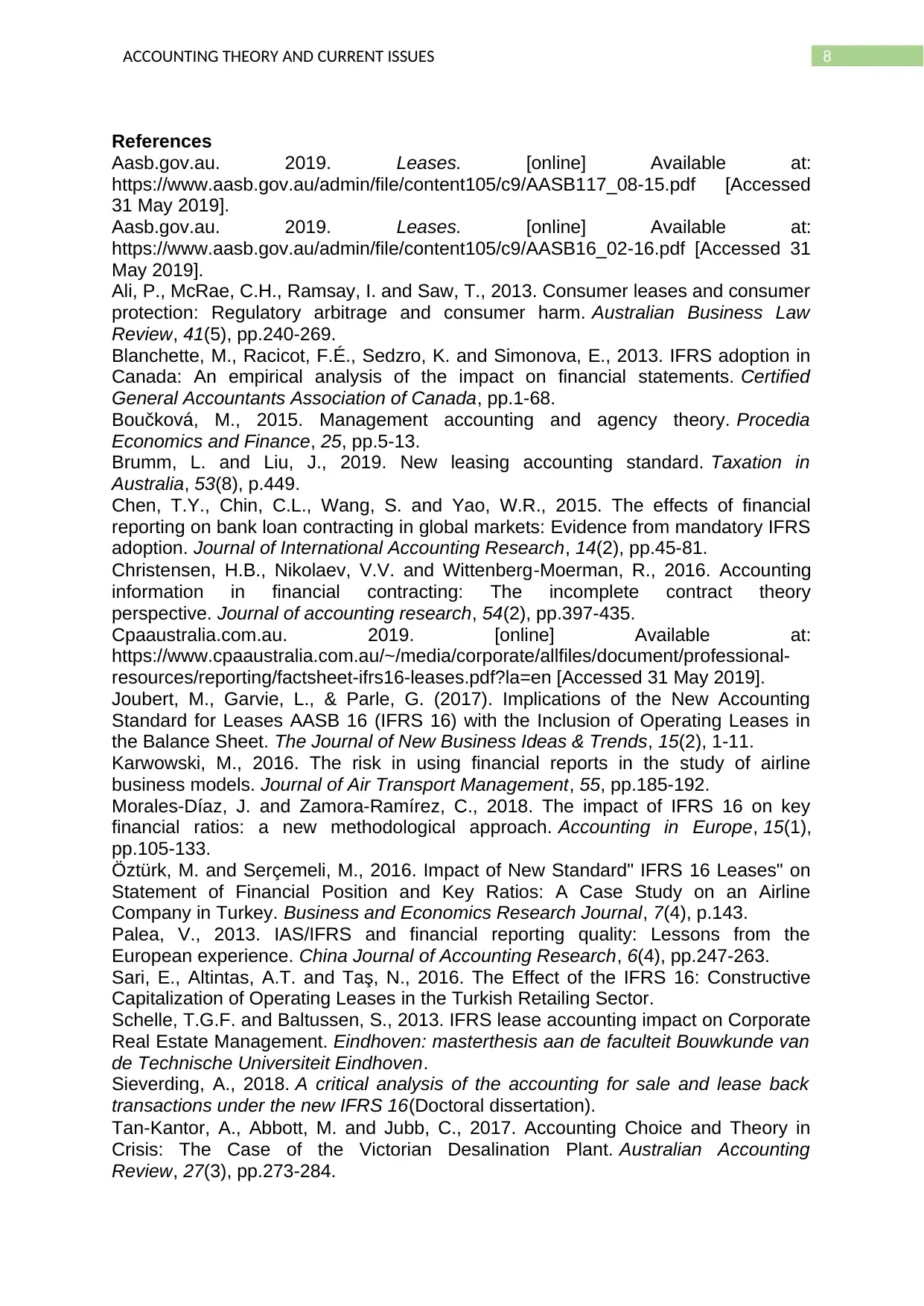
8ACCOUNTING THEORY AND CURRENT ISSUES
References
Aasb.gov.au. 2019. Leases. [online] Available at:
https://www.aasb.gov.au/admin/file/content105/c9/AASB117_08-15.pdf [Accessed
31 May 2019].
Aasb.gov.au. 2019. Leases. [online] Available at:
https://www.aasb.gov.au/admin/file/content105/c9/AASB16_02-16.pdf [Accessed 31
May 2019].
Ali, P., McRae, C.H., Ramsay, I. and Saw, T., 2013. Consumer leases and consumer
protection: Regulatory arbitrage and consumer harm. Australian Business Law
Review, 41(5), pp.240-269.
Blanchette, M., Racicot, F.É., Sedzro, K. and Simonova, E., 2013. IFRS adoption in
Canada: An empirical analysis of the impact on financial statements. Certified
General Accountants Association of Canada, pp.1-68.
Boučková, M., 2015. Management accounting and agency theory. Procedia
Economics and Finance, 25, pp.5-13.
Brumm, L. and Liu, J., 2019. New leasing accounting standard. Taxation in
Australia, 53(8), p.449.
Chen, T.Y., Chin, C.L., Wang, S. and Yao, W.R., 2015. The effects of financial
reporting on bank loan contracting in global markets: Evidence from mandatory IFRS
adoption. Journal of International Accounting Research, 14(2), pp.45-81.
Christensen, H.B., Nikolaev, V.V. and Wittenberg‐Moerman, R., 2016. Accounting
information in financial contracting: The incomplete contract theory
perspective. Journal of accounting research, 54(2), pp.397-435.
Cpaaustralia.com.au. 2019. [online] Available at:
https://www.cpaaustralia.com.au/~/media/corporate/allfiles/document/professional-
resources/reporting/factsheet-ifrs16-leases.pdf?la=en [Accessed 31 May 2019].
Joubert, M., Garvie, L., & Parle, G. (2017). Implications of the New Accounting
Standard for Leases AASB 16 (IFRS 16) with the Inclusion of Operating Leases in
the Balance Sheet. The Journal of New Business Ideas & Trends, 15(2), 1-11.
Karwowski, M., 2016. The risk in using financial reports in the study of airline
business models. Journal of Air Transport Management, 55, pp.185-192.
Morales-Díaz, J. and Zamora-Ramírez, C., 2018. The impact of IFRS 16 on key
financial ratios: a new methodological approach. Accounting in Europe, 15(1),
pp.105-133.
Öztürk, M. and Serçemeli, M., 2016. Impact of New Standard" IFRS 16 Leases" on
Statement of Financial Position and Key Ratios: A Case Study on an Airline
Company in Turkey. Business and Economics Research Journal, 7(4), p.143.
Palea, V., 2013. IAS/IFRS and financial reporting quality: Lessons from the
European experience. China Journal of Accounting Research, 6(4), pp.247-263.
Sari, E., Altintas, A.T. and Taş, N., 2016. The Effect of the IFRS 16: Constructive
Capitalization of Operating Leases in the Turkish Retailing Sector.
Schelle, T.G.F. and Baltussen, S., 2013. IFRS lease accounting impact on Corporate
Real Estate Management. Eindhoven: masterthesis aan de faculteit Bouwkunde van
de Technische Universiteit Eindhoven.
Sieverding, A., 2018. A critical analysis of the accounting for sale and lease back
transactions under the new IFRS 16(Doctoral dissertation).
Tan‐Kantor, A., Abbott, M. and Jubb, C., 2017. Accounting Choice and Theory in
Crisis: The Case of the Victorian Desalination Plant. Australian Accounting
Review, 27(3), pp.273-284.
References
Aasb.gov.au. 2019. Leases. [online] Available at:
https://www.aasb.gov.au/admin/file/content105/c9/AASB117_08-15.pdf [Accessed
31 May 2019].
Aasb.gov.au. 2019. Leases. [online] Available at:
https://www.aasb.gov.au/admin/file/content105/c9/AASB16_02-16.pdf [Accessed 31
May 2019].
Ali, P., McRae, C.H., Ramsay, I. and Saw, T., 2013. Consumer leases and consumer
protection: Regulatory arbitrage and consumer harm. Australian Business Law
Review, 41(5), pp.240-269.
Blanchette, M., Racicot, F.É., Sedzro, K. and Simonova, E., 2013. IFRS adoption in
Canada: An empirical analysis of the impact on financial statements. Certified
General Accountants Association of Canada, pp.1-68.
Boučková, M., 2015. Management accounting and agency theory. Procedia
Economics and Finance, 25, pp.5-13.
Brumm, L. and Liu, J., 2019. New leasing accounting standard. Taxation in
Australia, 53(8), p.449.
Chen, T.Y., Chin, C.L., Wang, S. and Yao, W.R., 2015. The effects of financial
reporting on bank loan contracting in global markets: Evidence from mandatory IFRS
adoption. Journal of International Accounting Research, 14(2), pp.45-81.
Christensen, H.B., Nikolaev, V.V. and Wittenberg‐Moerman, R., 2016. Accounting
information in financial contracting: The incomplete contract theory
perspective. Journal of accounting research, 54(2), pp.397-435.
Cpaaustralia.com.au. 2019. [online] Available at:
https://www.cpaaustralia.com.au/~/media/corporate/allfiles/document/professional-
resources/reporting/factsheet-ifrs16-leases.pdf?la=en [Accessed 31 May 2019].
Joubert, M., Garvie, L., & Parle, G. (2017). Implications of the New Accounting
Standard for Leases AASB 16 (IFRS 16) with the Inclusion of Operating Leases in
the Balance Sheet. The Journal of New Business Ideas & Trends, 15(2), 1-11.
Karwowski, M., 2016. The risk in using financial reports in the study of airline
business models. Journal of Air Transport Management, 55, pp.185-192.
Morales-Díaz, J. and Zamora-Ramírez, C., 2018. The impact of IFRS 16 on key
financial ratios: a new methodological approach. Accounting in Europe, 15(1),
pp.105-133.
Öztürk, M. and Serçemeli, M., 2016. Impact of New Standard" IFRS 16 Leases" on
Statement of Financial Position and Key Ratios: A Case Study on an Airline
Company in Turkey. Business and Economics Research Journal, 7(4), p.143.
Palea, V., 2013. IAS/IFRS and financial reporting quality: Lessons from the
European experience. China Journal of Accounting Research, 6(4), pp.247-263.
Sari, E., Altintas, A.T. and Taş, N., 2016. The Effect of the IFRS 16: Constructive
Capitalization of Operating Leases in the Turkish Retailing Sector.
Schelle, T.G.F. and Baltussen, S., 2013. IFRS lease accounting impact on Corporate
Real Estate Management. Eindhoven: masterthesis aan de faculteit Bouwkunde van
de Technische Universiteit Eindhoven.
Sieverding, A., 2018. A critical analysis of the accounting for sale and lease back
transactions under the new IFRS 16(Doctoral dissertation).
Tan‐Kantor, A., Abbott, M. and Jubb, C., 2017. Accounting Choice and Theory in
Crisis: The Case of the Victorian Desalination Plant. Australian Accounting
Review, 27(3), pp.273-284.
⊘ This is a preview!⊘
Do you want full access?
Subscribe today to unlock all pages.

Trusted by 1+ million students worldwide
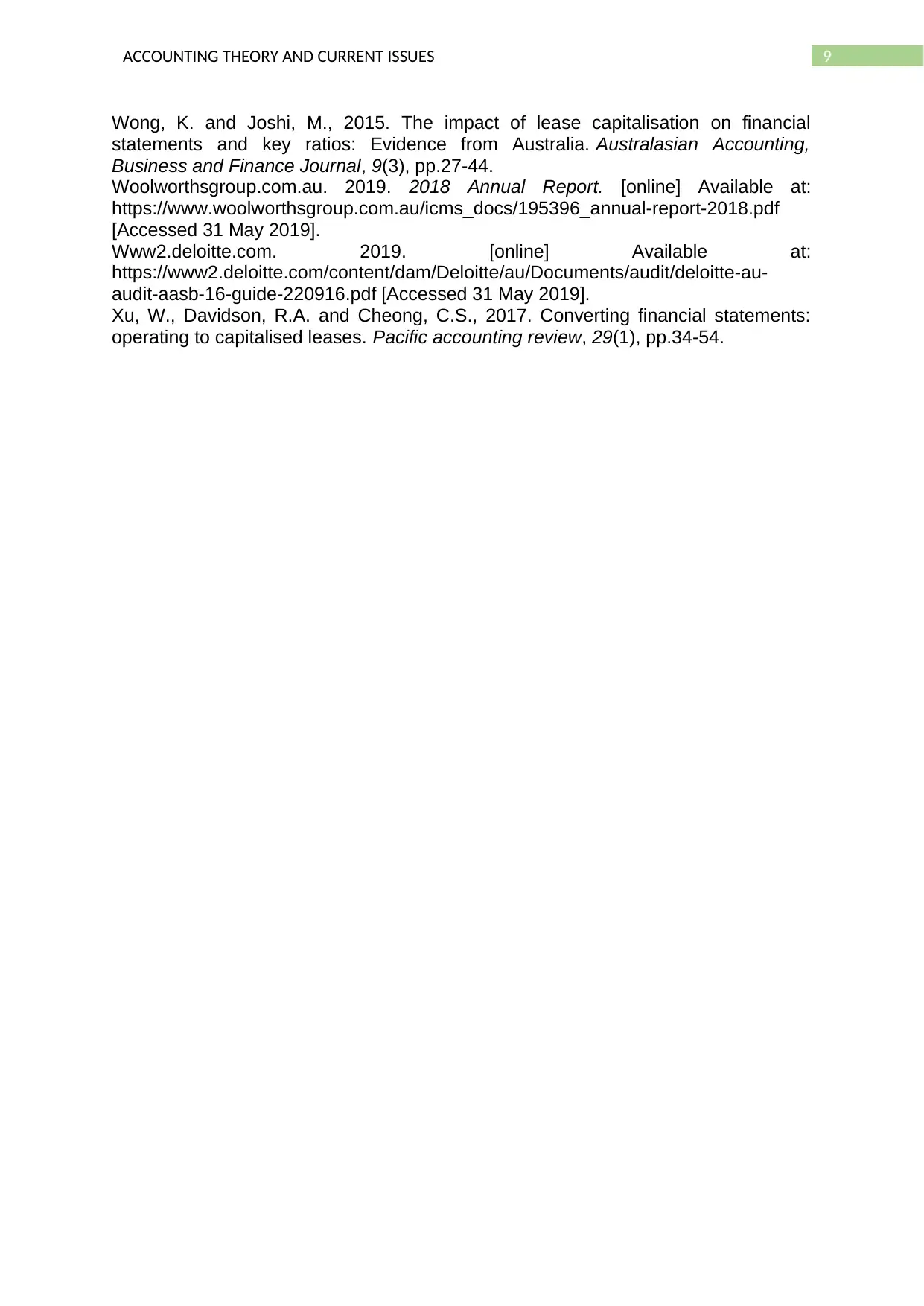
9ACCOUNTING THEORY AND CURRENT ISSUES
Wong, K. and Joshi, M., 2015. The impact of lease capitalisation on financial
statements and key ratios: Evidence from Australia. Australasian Accounting,
Business and Finance Journal, 9(3), pp.27-44.
Woolworthsgroup.com.au. 2019. 2018 Annual Report. [online] Available at:
https://www.woolworthsgroup.com.au/icms_docs/195396_annual-report-2018.pdf
[Accessed 31 May 2019].
Www2.deloitte.com. 2019. [online] Available at:
https://www2.deloitte.com/content/dam/Deloitte/au/Documents/audit/deloitte-au-
audit-aasb-16-guide-220916.pdf [Accessed 31 May 2019].
Xu, W., Davidson, R.A. and Cheong, C.S., 2017. Converting financial statements:
operating to capitalised leases. Pacific accounting review, 29(1), pp.34-54.
Wong, K. and Joshi, M., 2015. The impact of lease capitalisation on financial
statements and key ratios: Evidence from Australia. Australasian Accounting,
Business and Finance Journal, 9(3), pp.27-44.
Woolworthsgroup.com.au. 2019. 2018 Annual Report. [online] Available at:
https://www.woolworthsgroup.com.au/icms_docs/195396_annual-report-2018.pdf
[Accessed 31 May 2019].
Www2.deloitte.com. 2019. [online] Available at:
https://www2.deloitte.com/content/dam/Deloitte/au/Documents/audit/deloitte-au-
audit-aasb-16-guide-220916.pdf [Accessed 31 May 2019].
Xu, W., Davidson, R.A. and Cheong, C.S., 2017. Converting financial statements:
operating to capitalised leases. Pacific accounting review, 29(1), pp.34-54.
1 out of 10